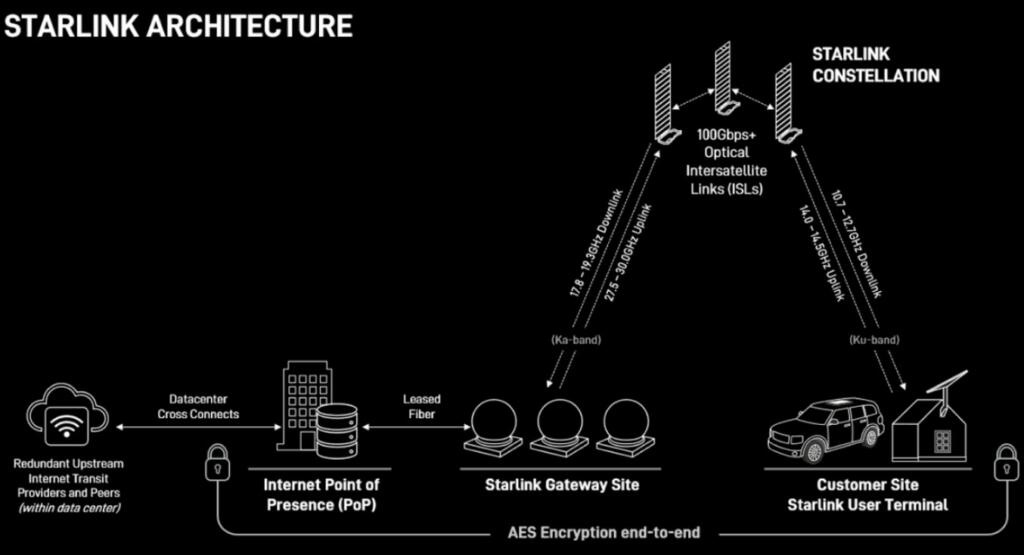A SpaceX Starlink paper on Latency shows a picture of the Starlink system with an SUV with a flat Starlink dish build into the car. There have been people taking flat satellite dishes and attaching them to their cars. The SpaceX Starlink picture suggests that SpaceX Starlink will make a flat dish that would be built into the roof of a car, truck or SUV or attached with minimal drag and other issues.
A car or truck highspeed Starlink service would be a capability that other providers would not be able to compete other than the mobile 5G internet services which have large coverage gaps during road trips.
Starlink engineering teams have been focused on improving the performance of our network with the goal of delivering a service with stable 20 millisecond (ms) median latency and minimal packet loss.
Starlink now has over 2.6M+ customers.
Over the past month, SpaceX have meaningfully reduced median and worst-case latency for users around the world. In the United States alone, we reduced median latency by more than 30%, from 48.5ms to 33ms during hours of peak usage. Worst-case peak hour latency (p99) has dropped by over 60%, from over 150ms to less than 65ms. Outside of the United States, we have also reduced median latency by up to 25% and worst-case latencies by up to 35%.
In the first two months of 2024, Starlink teams have deployed and tested 193 different satellite software builds, 75 gateway software builds, 222 Starlink software builds, and 57 WiFi software builds.
In 2023, Google Fiber as the only Broadband Upload Speed with a score of over 100 Mbps 106.9Mbps across the whole U.S. AT&T FTTH and Verizon FTTH are in second and third place respectively.



Latency
Latency refers to the amount of time, usually measured in milliseconds, that it takes for a packet to be ent from your Starlink router to the internet and for the response to be received. This is also known as “round-trip time”, or RTT. Latency is one of the most important factors in your perceived experience when using the internet – web pages load faster, audio and video calls feel closer to real-life, and online gaming feels responsive. As an example, testing has shown that increasing bandwidth beyond around 10 Mbps does not increase web-page load time, but a reduction in latency results in substantially lower load times.
What Needs to Be Improved for Great Starlink Latency?
Latency in the Starlink network is driven by several factors. The biggest ones are:
• Physical speed-of-light propagation from the user to the satellite and back to the ground. This is in the range of 1.8-3.6ms per leg, and usually under 10ms for the round-trip. Additional latency can be induced if traffic flows over laser links, instead of directly to the ground (as a result of congestion mitigation, lack of satellite to ground paths, or other factors). While laser connectivity is essential for connecting the most remote locations on Earth and for routing around congestion in the network, we are making strides to ensure that latency sensitive traffic can flow over the shortest path possible.
• Ground latency from the gateway sites to the internet connection point driven by ground network layout. In 2024, we are adding 6 internet connect locations (called Points of Presence, or PoPs) in the US and are optimizing gateway locations and our planning algorithms to ensure that traffic can land as close to its destination point as possible. We will continue to ensure that users are allocated to optimal internet connection locations, so that all users get the lowest
latency possible route to the internet.
• Fronthaul (the radio links between the satellite and user) scheduling latency driven by the network topology and the number of users served by a given beam from a satellite. While this latency is an inherent part of shared wireless systems, there is significant room for optimization, and this has been a major focus in the past several months.
• Dumb stuff driven by non-physical limitations in our system – unneeded processing delays, unoptimized buffers, or unnecessary packet drops that force retries. Buffers across our network have been right sized to reduce bufferbloat, and queueing algorithms have been improved to increase capacity on our gateway links from the ground to satellites. Our WiFi latency has been improved, with the addition of active queue management, fq_codel, to the Starlink WiFi router. With active queue management enabled, when one person on your WiFi is downloading a big file, and another is playing a game, the game latency will not be affected by the download.

Brian Wang is a Futurist Thought Leader and a popular Science blogger with 1 million readers per month. His blog Nextbigfuture.com is ranked #1 Science News Blog. It covers many disruptive technology and trends including Space, Robotics, Artificial Intelligence, Medicine, Anti-aging Biotechnology, and Nanotechnology.
Known for identifying cutting edge technologies, he is currently a Co-Founder of a startup and fundraiser for high potential early-stage companies. He is the Head of Research for Allocations for deep technology investments and an Angel Investor at Space Angels.
A frequent speaker at corporations, he has been a TEDx speaker, a Singularity University speaker and guest at numerous interviews for radio and podcasts. He is open to public speaking and advising engagements.


With low latency combined with an ability to track all neighboring cars and either prevent or account for all pedestrians, pets, motor cycles or cyclists perhaps you could do away with speed limits, traffic lights and stop signs all together. At least important for emergency services.